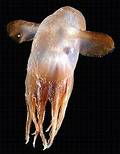 任職於伍茲赫爾海洋研究所(Woods Hole Oceanographic Institution)並參與「海洋生物普查」的的傑曼博士表示,「深海是地球最大的連續性生態系、生物最大的棲地,但也是人們所知最少的環境。」在來自34國參與普查的344位科學家當中,傑曼博士負責調查深海生物。
任職於伍茲赫爾海洋研究所(Woods Hole Oceanographic Institution)並參與「海洋生物普查」的的傑曼博士表示,「深海是地球最大的連續性生態系、生物最大的棲地,但也是人們所知最少的環境。」在來自34國參與普查的344位科學家當中,傑曼博士負責調查深海生物。
到明年10月,「海洋生物普查」將結束十年的研究工作;屆時5項深海調查計畫將出航210次,其中包含史無前例的對赤道以南的中大西洋海脊的探索。這項創舉是由俄羅斯、巴西、南非和烏拉圭在於今年10-11 1月間合作的科學研究。
此計畫14個調查地點中,有5個位於不見天光的海洋深處。每個調查地點都是為了在各種極深的海洋環境研究生命的樣貌:從大陸邊緣到延伸至中大西洋的海脊、海底隆起的山脈、泥質的海洋平原;或是海洋中脊邊緣及最深的海溝中發現的熱泉、滲漏和化學作用形成的生態系。
每個航次皆耗資龐大,且受到極端海況的挑戰,使得直至2000年海洋普查開始前,深海一直是遙不可及。
研究結果仍在分析中,將在明年10月4日於倫敦發表最後的普查結果。然而科學家已知,全球深海生物的數量、分佈和多樣性等模式已十分明顯。
「海洋生物地理資訊系統」(Ocean Biogeographic Information System)紀錄了海洋生物普查的觀察資料。管理此系統的博格(Edward Vanden Berghe),在深於200公尺以下、無法行光合作用的海中,記錄了17650種物種;其中處於深度超過1000公尺的就有5,722種物種。
舉例來說,最近一次至大西洋東南部的航次收集了680個橈足類標本,當中只有7種可被鑑定出,99%是從未發現的物種。而從各地收集、數百種類似蚯蚓大小的大型海洋動物標本中,50%-85%是科學家無法辨認的新種。更罕見的是一種新的海參,那不僅是新的物種、更是一個新的「屬」。
"The deep sea is the Earth's largest continuous ecosystem and largest habitat for life. It is also the least studied," says Dr. Chris German of Woods Hole Oceanographic Institution, one of 344 scientists from 34 nations working to identify deep sea creatures for the Census of Marine Life.
By the time the 10-year Census of Marine Life concludes in October 2010, five deep-sea projects will have fielded a total of 210 expeditions, including the first ever voyage to explore the Mid-Atlantic Ridge south of the Equator. The scientific collaboration between Russia, Brazil, South Africa and Uruguay took place in October-November this year.
Five of the Census' 14 field projects plumb the ocean depths beyond light. Each is dedicated to the study of life in progressively deeper realms - from the continental margins to the spine-like ridge running down the mid-Atlantic, the submerged mountains rising from the seafloor, the muddy floor of ocean plains, and the vents, seeps and chemically-driven ecosystems found on the margins of mid-ocean ridges and in the deepest ocean trenches.
Each voyage is enormously expensive and challenged by extreme ocean conditions and requirements that have kept the remotest reaches of the sea impenetrable until the Census began in 2000.
While the collective findings are still being analyzed as part of the final Census report to be released in London on October 4, 2010, scientists say patterns of the abundance, distribution and diversity of deep-sea life around the world are already apparent.
Edward Vanden Berghe, who manages the Ocean Biogeographic Information System, the Census' inventory of marine life observations, has compiled records of 5,722 species for which all recorded observations are deeper than 1,000 meters (.62 miles) and 17,650 species for which all recorded observations are deeper than 200 meters, the depth where darkness stops photosynthesis.
Of some 680 specimens of copepods collected on a recent CeDAMar cruise to the southeastern Atlantic, for example, only seven could be identified; 99 percent were new to science. And among hundreds of species of macrofauna - animals about the size of an earthworm - collected in different areas, 50 to 85 percent were unrecognized. Far rarer than new species in the mud is the capture of a new species of sea cucumber, and rarer still a new genus.
全文及圖片詳見:ENS





